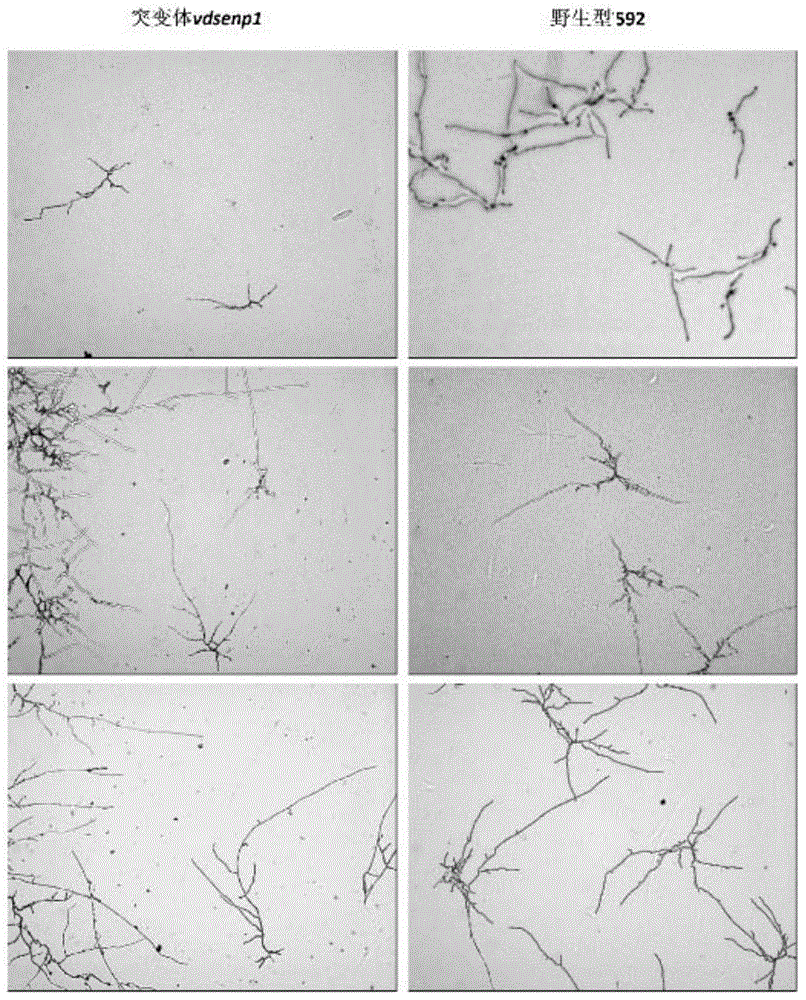Verticillium dahliae Kleb. pathogenic associated protein VdSENP1 and encoding gene thereof
A technology of Verticillium dahliae and coding gene, which can be applied in the biological field and can solve the problems of strong variation of race differentiation, difficult research, difficulty in genetic breeding of disease resistance, etc.
- Summary
- Abstract
- Description
- Claims
- Application Information
AI Technical Summary
Problems solved by technology
Method used
Image
Examples
Embodiment 1
[0045] Example 1. Preparation of the pathogenic gene VdSENP1 of Verticillium dahliae Kleb.
[0046] The wild-type strain 592 of Verticillium dahliae was extracted (strain 592 was collected from a cotton field in Xinjiang, and the literature recording this material is a rapid detection of the pathogenic type of Verticillium dahliae in cotton plants. Xinjiang Agricultural Science 2010, 47(4): 827- 831, which the public can obtain from the Institute of Microbiology, Chinese Academy of Sciences) was reverse-transcribed into cDNA, and using the cDNA as a template, RT-PCR amplification was carried out with the following primers 1 and 2:
[0047] Primer 1: g CCCGGG ATGGGGTCAAAAAAACATGTCC (upstream primer, the underlined part is Sma I);
[0048] Primer 2: c ACTAGT TCATGCATAAGGATATTCGC (downstream primer, underlined part is Spe I).
[0049] The PCR amplified product is proved by cloning and sequencing, the amplified product has the nucleic acid sequence shown in the 383-3577th n...
Embodiment 2
[0050] Example 2. Functional verification of the pathogenic gene VdSENP1 of Verticillium dahliae Kleb.
[0051] (1) Construction of expression vector
[0052] The construction method of the fungal expression vector 1300HPH-VdSENP1 is as follows: first, the vector pCAMBIA-1300221 (the document recording the pCAMBIA-1300221 plasmid is Satellite RNA-derived satsiR-12 targeting the 3'UTR of Cucumber mosaic virus triggers viral RNAs for degradation. Journal of Virology.201185.13384-13397, the public can obtain the plasmid from the Institute of Microbiology, Chinese Academy of Sciences.) Digest the vector fragment and pKOV21 vector with Sma I (the document describing the pKOV21 vector is Different chitin synthase genes are required for various developmental and plant infection processes in the rice blast fungus Magnaporthe oryzae, PLoS Pathogen, 20128: e1002526, and the public can obtain the plasmid from the Institute of Microbiology, Chinese Academy of Sciences.) The HPH fragment o...
Embodiment 3
[0139] Example 3. Research on other functions of the pathogenic gene VdSENP1 of Verticillium dahliae Kleb.
[0140] (1) VdSENP1 gene plays a role in promoting the growth and development of Verticillium dahliae hyphae
[0141] Bacterial blocks were excavated from the Verticillium dahliae wild-type strain 592 grown on the PDA plate and placed in Chapeauer's medium for cultivation at 28° C. and 200 rpm. On the fourth day, the materials were collected, the spores were filtered out with four layers of gauze, and the RNA of the mycelia and spores were extracted respectively, and the northern hybridization was carried out. The nucleotide sequence of the probe has the sequence shown in the 2154th-2580th nucleotides of SEQ ID No. 1 in the sequence listing. See the results of Northern hybridization Figure 7 , Figure 7 The results showed that the expression level of VdSENP1 gene in mycelia was higher than that in spores, and the colonies of mutant vdsenp1 grew slowly. figure 2 See...
PUM
 Login to View More
Login to View More Abstract
Description
Claims
Application Information
 Login to View More
Login to View More - R&D Engineer
- R&D Manager
- IP Professional
- Industry Leading Data Capabilities
- Powerful AI technology
- Patent DNA Extraction
Browse by: Latest US Patents, China's latest patents, Technical Efficacy Thesaurus, Application Domain, Technology Topic, Popular Technical Reports.
© 2024 PatSnap. All rights reserved.Legal|Privacy policy|Modern Slavery Act Transparency Statement|Sitemap|About US| Contact US: help@patsnap.com










